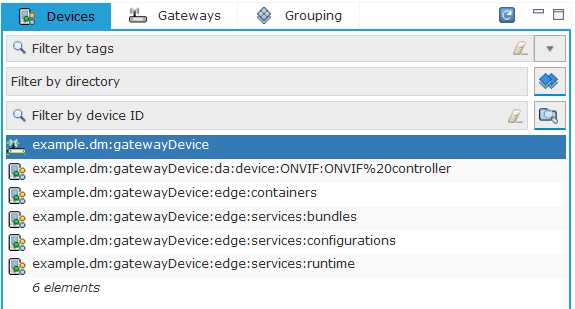List and filter devices
At this point we assume you already went through the previous sections and have successfully registered a device.
For the sake of a richer example, we have connected an Edge Services runtime to our Edge Agent. Learn how to do that via Enable Edge Services.
All your registered devices will be listed in the Device Management perspective, from where you can organize, search and filter them, monitor their state and resources, and appoint management actions supported by them.
Table of contents:
List devices
The system distinguishes two general types of connected devices - gateways and edge devices.

Devices view
The Devices view lists all devices without filtering them by type, meaning that your device should be listed here regardless of whether it is a gateway or an edge device.
Devices are listed in alphabetical order according to their unique IDs. Their type can be easily determined through their corresponding icons - ![]() for gateways and
for gateways and ![]() for edge devices.
for edge devices.
In the case of installed Edge Services, the icon for edge devices will appear not only for the digital twin representation of the physical device, but also for the digital twin representations of Edge Services runtime, OSGi bundles and configurations. Find out more about them in the module description of Bosch IoT Edge Services.

The default amount of loaded devices is 20 - to display more click show more.
![]()
This default device number can be modified from the View page size option in the Settings menu.
Gateways view
The Gateways view lists all registered gateways. Expand a gateway to view all its connected edge devices.

The next view - Grouping - is explained in a separate page called Create a device group.
Filter devices
The following filtering mechanisms are identical for both the Devices and Gateways views:
Filter by tags
To filter the connected devices according to their tags:
Open the Filter by tags drop down menu
Select the relevant tags from the list that appears. You may select as many tags as you need for your filter and deselect them by clicking them once again
Alternatively, you may directly type the name of the tag and press enter. For multiple tags - separate them with a comma
Click Search upon which the filtered devices will appear in the list of devices

Filter by directory
Filtering by directory is useful when you want to address multiple devices belonging to a specific directory group.
Click Filter by directory - ![]() and select the relevant directory from the Device tree.
and select the relevant directory from the Device tree.
The view will then be filtered to show only the devices part of that directory.
To clear the filter, select the top /ROOT directory once again.
Creating Tag groups and Directories is explained as part of Create a device group.
Filter by ID or RQL expression
To Filter by device ID, write a part of or the full ID of a device for a specific search.
Erase the input by using the Eraser ![]() button.
button.
Switching the search between a device ID and an RQL expression filter is possible via the corresponding button, as illustrated below:

A dialog will appear where you should select the filter type - a device ID, a manually entered RQL filter or an already saved one.

Depending on your selection, either:
Write down the relevant RQL filter and press Enter, or
Open the dropdown menu and select the relevant pre-saved filter, then click Search.
All filtering mechanisms can be combined without any restrictions. To erase all applied filters use the Refresh / Revert button.